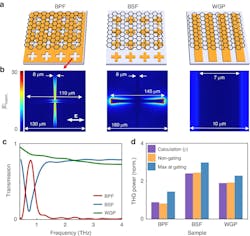Graphene Layers and Lasers Create Unusual Terahertz Source
What you’ll learn:
- The need for improvements in terahertz-spectrum sources.
- How lasers and graphene layers are being used to create harmonics into the THz band.
- The multiple experiments that were run and the overview of results.
It seems like almost every day we hear of another interesting, unusual, and often viable use for graphene, the single-atom-thickness layer of graphite. It was created in the early 2000s and led to a 2010 Nobel Prize in Physics for Andre Geim and Konstantin Novoselov. Similarly, we’re no longer shocked by the many fascinating and diverse applications for lasers of all wavelengths and powers (you can make your own list) as they come at an almost daily pace.
Now there’s a development that combines both graphene and lasers to create terahertz waves with relatively high efficiency, combining these two seemingly unrelated technologies. Researchers have begun to develop devices capable of upconverting gigahertz signals in the electromagnetic spectrum to higher oscillation frequencies. Their work bridges the gap between gigahertz electronics and terahertz (THz) photonics.
The terahertz band is, at least for now, somewhat of a spectrum oddity, positioned between microwaves and infrared light and roughly spanning from 0.1 THz (100 GHz/3 mm wavelength) to 10 THz (30 μm). That’s a region where our RF solid-state and vacuum-tube devices have great difficulty sourcing and receiving signals, while the wavelengths are too long for conventional optical devices. At the same time, terahertz waves would be a good fit for many sensing and other applications, in addition to the incredible bandwidth and data rates it potentially offers.
Leveraging Graphene’s Optical Properties
This research by a team the University of Ottawa (Canada), University of Bayreuth (Germany), and Iridian Spectral Technologies (Ottawa) leverages the unique optical properties of graphene. They note that previous efforts at combining light and graphene primarily focused on fundamental light-matter interactions, often examining the effect of a single parameter in the experiment. The resulting nonlinear effects were extremely weak, primarily due to the atomically thin interaction length.
To overcome this limitation, the team combined multiple innovative approaches to enhance nonlinear effects and fully leverage graphene’s unique properties. They investigated the enhancement of third-harmonic generation (THG) in chemical vapor deposition (CVD) graphene through three distinctive approaches:
- First, they investigated the nonlinear response of stacked decoupled graphene sheets, ranging from one to 15 layers. Results show a correlation between the field strength of the generated third harmonic and the increasing number of graphene layers with a maximum nonlinear signal observed for six layers, partially due to a tradeoff between enhanced interaction length and linear absorption.
- Then, they used an electrical gate to investigate the effect of doping concentration in a one-, two-, and three-layer graphene stack.
- Finally, they looked at the effect of a metallic patterned substrate to locally enhance the THz driving field. They compared three types of metasurfaces acting on the THz driving field as a bandpass filter, a bandstop filter, and a linear wire-grid polarizer (WGP). The two kinds of spectral filters provide larger field enhancements than any previously reported metasurface substrates, up to now, used in these THz HHG experiments.
The optical nonlinearity of graphene is closely linked to the transport dynamics of its carriers in response to an applied electric field. Unlike visible or near infrared (NIR) excitations leading to interband transitions, a terahertz driving field causes intraband transitions. They also proposed a simple model estimate the THG enhancement factor based on the metasurface geometry.
Testing Results
In one experimental configuration (Fig. 1), the sensitive detection of the THG signal required the use of a low-pass filter (LPF), reducing the spectral width of the pump pulse and eliminating any residual pump at the third-harmonic frequency.
They tested six nonlinear samples consisting of stacked graphene sheets, from one to 15 layers, allowing them to vary the nonlinear interaction length. Figure 2 shows the spectrum of the terahertz pulse (blue line) transmitted through the LPF and used as the pump at the fundamental frequency ω (this graph only contains spectral measurements collected with the one-, three-, and six-layer graphene samples—purple, green, and red lines, respectively—for enhanced clarity of the display).
The largest nonlinear signal was obtained with the stack of six layers. This sample yields a THG peak amplitude that’s a factor of ×5.8 (or ×33 in peak intensity) larger than the one obtained with the single graphene sheet. They didn’t observe further increase of the THG peak amplitude using a stack of 10 or 15 layers due to linear losses experienced by the pump and the third-harmonic signal.
In another series of experiments, different types of metasurfaces were used as substrate to explore the effect of local field enhancement on THG in an architecture combining multilayer graphene and an electrical gate (Fig. 3).
Three different designs of metasurfaces were considered based on their distinctive spectral transmission properties at the THz-pump frequencies; Figure 3a shows a schematic of these samples. They consist of a cross-slot bandpass filter (BPF), a cross-shaped bandstop filter (BSF), and a wire-grid polarizer (WGP). Interestingly, the most efficient design is a bandstop filter (BSF) at the fundamental frequency, featuring a threefold increase in THG power.
Is It Terahertz Time?
This increasing interest in terahertz sources and the many ways to create them indicates that this “in-between” band will likely become more accessible and useful. Obviously, we don’t know yet which one(s) of these, if any, will be viable practical devices.
The team’s advanced, deep-physics work is described in their detailed and somewhat esoteric paper “Strategies to enhance THz harmonic generation combining multilayered, gated, and metamaterial-based architectures”—with associated readability challenges—published in Light Science and Applications from Springer Nature Limited.
About the Author

Bill Schweber
Contributing Editor
Bill Schweber is an electronics engineer who has written three textbooks on electronic communications systems, as well as hundreds of technical articles, opinion columns, and product features. In past roles, he worked as a technical website manager for multiple topic-specific sites for EE Times, as well as both the Executive Editor and Analog Editor at EDN.
At Analog Devices Inc., Bill was in marketing communications (public relations). As a result, he has been on both sides of the technical PR function, presenting company products, stories, and messages to the media and also as the recipient of these.
Prior to the MarCom role at Analog, Bill was associate editor of their respected technical journal and worked in their product marketing and applications engineering groups. Before those roles, he was at Instron Corp., doing hands-on analog- and power-circuit design and systems integration for materials-testing machine controls.
Bill has an MSEE (Univ. of Mass) and BSEE (Columbia Univ.), is a Registered Professional Engineer, and holds an Advanced Class amateur radio license. He has also planned, written, and presented online courses on a variety of engineering topics, including MOSFET basics, ADC selection, and driving LEDs.



